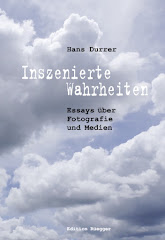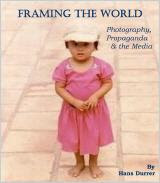My usual complaint about photo books is that somebody, a photographer or a publisher or both, simply throws photographs at me without any, or hardly any, accompanying information as if to say: "Do with it what you like." As I've written on many occasions: I find this rather cheap. Moreover, I feel left alone with all my questions ... and I already have enough unanswered questions myself so I really do not want to be given extra-work ...
However, many of the convincingly composed shots in Jacqueline Hassink's View, Kyoto do not need more information than the photographer volunteers in the introduction."Today the city houses some 1,600 Buddhist temples. Each has its own unique garden ... In Buddhism the temple is seen as the human realm, whereas the garden represents the realm of the Buddha. The veranda is the line that separates these two worlds. This separation is temporary, and eventually through meditation the Buddha (nature) and humans become one."
View, Kyoto is divided into three sections. "Garden and Temple" in which the garden is photographed from deep inside the temple, followed by the "Temple" section that deals with space inside the temple. The third section is the "Garden", the focus here is on nature.
It is a large format tome, the angles were intelligently chosen, the colours are stunning, and there's also the impressive print quality of the shots.
Apart from the stunning photos, there is also a conversation between Jacqueline Hassink and the scientist Gert van Tonder, who has done research on the perceptual effects of Japanese rock gardens. When van Tonder asks for the reasons why there are no people in the photographs, Hassink replies: "I think there is a human presence in the images, because the gardens and spaces that I photograph are made by human hand. So even though the temple monks or visitors are not shown in the images, they are present indirectly."
She surely has a point there. On the other hand: with this kind of logic there can be no emptiness in, say, public buildings or squares ... and that I find slightly absurd.
Gert van Tonder: "Whenever I take a photograph. I am always struck by the great limitation of the camera compared to how we can move our eyes and heads to seamlessly perceive a three-dimensional space. The moment one looks through the viewfinder this all disappears, and one sees a very small and flat segment of the world. Is this an advantage to you as a photographer, or a limitation?"
Jacqueline Hassink: "No, I see this differently. However, there are two aspects to what you describe that I think are relevant. First, if you have a photograph printed on a very large scale and with a certain printing technique, then it is possible to bring the illusion of three-dimensional space into the photographic image. Second, in the world of the iPhone and all the input that surrounds us, I think photography is a really good tool for framing one's thoughts at a particular moment in a single image.. Also important, I do not consider photography an experience of limitation. Instead it causes my brain to focus on the core of what I want to capture, on what I consider the essence of the temple or the garden."
This is the way I see it: to focus means to shut out what distracts, and thus to limit one's world-view. It
is, however, in narrowing the scope that we broaden the horizon – which is precisely my experience with Jacqueline Hassink's photographs.
Jacqueline Hassink
View, Kyoto
Hatje Cantz, Ostfildern 2014























No comments:
Post a Comment